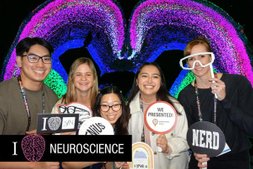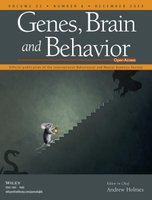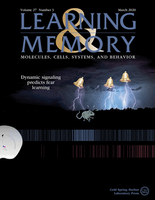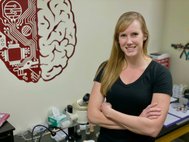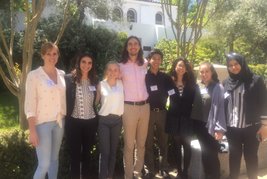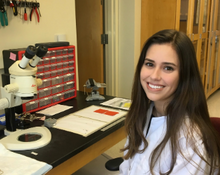Research conducted in the Neural Circuits, Systems, & Behavior Lab, headed by Dr. Lindsay Halladay, is focused on understanding the physiological processes by which neural activity produces behavior, and more specifically, how dysfunctional circuitry leads to aberrant behavior. NCSB's objective is to better understand how reward and aversion circuits converge and interact. Using a combination of in vivo electrophysiology, behavior, and genetic tools, the Halladay Lab's ultimate goal is to clarify how factors such as stress and alcohol exposure alter neural signaling and influence circuitry in a way that promotes addictive-like behaviors.
Follow us on Twitter! @halladaylab
The Halladay lab is relocating to the University of Arizona!
Hiring at all levels in January 2025!
Circuits, Systems, & Behavior
Discovering how complex signals encode behavior
Halladay Lab at Santa Clara University
News:
5.1.24
Congrats to Sean Do, who was awarded a De Novo Fellowship to conduct research in the lab during summer 2024.
11.13.23
The Halladay lab traveled to D.C. to present four posters at SFN. Presenters included
Michael Nguyen,
Janet Ronquillo,
Linnea Rothi, and
Varya Zlotnik.
10.23.23
Check out the lab's latest publication in Genes, Brain, & Behavior: Nature and nurture: Comparing mouse behavior in classic versus revised anxiety-like and social behavioral assays in genetically or environmentally defined
groups, co-authored by Janet Ronquillo,
Michael Nguyen, Linnea Rothi, Danny
Bui-Tu, and Jocelyn Yang, and was
featured on the cover of GBB.
10.11.23
Research in the Halladay Lab was highlighted in a recent article, Your Brain on Anxiety.
9.12.23
Lindsay Halladay was awarded SCU's Bernard Hubbard S.J. Creative Collaboration Award in recognition of having established a well-deserved reputation for excellence in research and mentoring.
5.8.23
New lab publication in Current Protocols Neuroscience:
Investigating Neural Correlates of Behavior Through In Vivo Electrophysiology.
5.1.23
Congratulations are in order for several of our RAs! Varya Zlotnik was awarded an APA SUPER summer fellowship, Michael Nguyen received a 2-year research fellowship from the ALZA Corporation, and Sean Do and Kevin Shimizu were each awarded REAL summer research grants from SCU.
4.26.23
The Halladay Lab traveled to Huntington Beach, CA to present 2 posters at the International Conference on Learning and Memory.
12.23.22
The Halladay lab published a new paper in Neuropharmacology, Lasting impact of
postnatal maternal separation on the
developing BNST: Lifelong socioemotional
consequences. The article was featured
on the cover:
5.1.22
Three of our amazing RAs received research awards and grants: Janet Ronquillo was selected as a DeNardo Science Scholar, and was awarded one year of funding to conduct research in the Halladay lab. Additionally, summer research funding was awarded to De Novo Fellow Kerri Lyons and REAL fellow Jocelyn Yang.
4.27.22
The Halladay Lab traveled to Portland, OR to present 5 student-authored posters at the Western Psychological Association conference. Congrats to Kerri Lyons for receiving a WPA student scholarship.
3.28.22
Halladay Lab RA Michael Nguyen was selected to receive a a scholarship from the Barry Goldwater Scholarship and Excellence in Education Foundation. Congrats!
1.15.22
The Halladay Lab recieved a Diversity Outbred Pilot Grant from the Jackson Laboratory, to investigate the effects of early life stress on adulthood behaviors in JAX Diversity Outbred mice.
8.27.21
Lindsay Halladay received a
the Brain and Behavior Research Foundation, supported by the Walder Family. The award will fund two years of research related to the neural and behavioral deficits resulting from early life trauma.
7.14.21
The Halladay lab was awarded a three year NIH R15 AREA grant, which will fund studies investigating the consequences of early life stress on neural circuitry underlying
social-, reward-, and aversion-
related behavior.
5.1.21
Several of our stellar RAs received research awards and grants: Natalie Rovero was selected to receive the prestigious DeNardo Senior Prize for her research accomplishments in the lab. Linnea Rothi became one of SCU's newest DeNardo Science Scholars and was awarded two years of funding to conduct research in the Halladay lab. Additionally, summer research funding was awarded to De Novo Fellows Avery Curet, Janet Ronquillo, Michael Nguyen, and Danny Bui-Tu, as well as REAL fellowKerri Lyons. Congratulations!
3.13.21
The Halladay Lab has a new paper out, in Behavioural Brain Research, detailing the life long social behavioral deficits induced by early life stress and the finding that low dose ethanol counteracts some social deficts, specifically in adolescent females.
3.11.21
In collaboration with colleagues at the NIAAA and University of Miami, Lindsay Halladay published a review article in the Journal of Neurochemistry, Advances in understanding meso‐cortico‐limbic‐striatal systems mediating risky reward seeking.
12.15.20
In collaboration with researchers at the NIAAA, the Halladay lab published exciting new work in eLife, identifying a prefrontal-bed nucleus of the stria terminalis circuit in the regulation of fear under during uncertain threat. This work has clinical implications for understanding neural underpinnings of trauma-related disorders.
6.9.20
The Halladay Lab published a new study in the Journal of Neuroscience Research, highlighting the bed nucleus of the stria terminalis as a potential mediator of social behavior dysregulation following early life trauma.
3.27.20
Congratulations to RA Max Bjorni for being awarded a scholarship from the Barry Goldwater Scholarship and Excellence in Education Foundation!
2.18.20
The Halladay Lab published a study in Learning
and Memory, identifying two functionally
distinct neural populations in the extended
amygdala that encode and predict cued fear
learning.
1.28.20
Lindsay Halladay presented new Halladay Lab findings at the Winter Conference on Brain Research in Big Sky, MT. Two invited talks included data on the neural circuits governing defensive action selection, as well as fear responding in the face of uncertain outcomes - data shedding light on inappropriate defensive responding characteristic of anxiety disorders and PTSD.
1.16.20
In an interview with Elemental, Lindsay Halladayspoke about her recently published findings on the neural circuits regulating drinking behavior in "The Latest Findings on Why It’s So Hard to Quit Drinking."
12.18.19
Lindsay Halladay and colleagues at the
NIAAA published an article in Biological
Psychiatry, identifying a corticostriatal
circuit involved in regulating punished
ethanol seeking. Read the press release
here.
10.19.19
The Halladay lab traveled to Chicago, IL to present their work at the annual meeting of the Society for Neuroscience. Max Bjorni received a travel award from the Faculty for Undergraduate Neuroscience. Other presenting RAs included Hannah Henderson, Natalie Rovero, and Alex Quan.
7.26.19
Lindsay Halladay traveled to SRI International to present the lab's research on neural and behavioral regulation of ethanol-seeking behavior.
7.11.19
Max Bjorni was selected to receive a competitive travel award by Faculty for Undergraduate Neuroscience (FUN) to present his research at this year's upcoming Society for Neuroscience meeting in October. See you in Chicago!
5.17.19
The Halladay lab attended and presented four posters at the Bay Area Brain Symposium, co-organized and hosted by Lindsay Halladay, the Vice President of the Bay Area Chapter of the Society for Neuroscience (SFN). RAs Max Bjorni, Natalie Rovero, and Alex Quan brought home their second 'Best Poster' award in just two weeks, for their work on adulthood behavioral and neural consequences of early life adversities on reward seeking.
5.4.19
Halladay Lab RAs presented their research at the Western Psychology Conference for Undergraduate Research, whereMax Bjorni,Natalie Rovero, and
Alex Quan won the award
for best poster. Their work
examines how developmental
adversities such as early life
stress and adolescent alcohol
exposure impact adulthood
reward seeking.
5.2.19
DeNardo Science Scholars Malia Belnap and Max Bjorni were selected to present their research on neural correlates of social behavior and ethanol reward preference at the Sigma Xi poster session at SCU.
5.2.19
Max Bjorni was honored with the
prestigious DeNardoScience Scholar
award, a 2 year grant to conduct
research on neural circuits underlying
stress-induced drinking behavior. Hannah Henderson and Noel Del Toro were each awarded a De Novo Science Scholar summer research grant. Natalie Rovero and Alex Quan received summer research grants from SCU's innovative REAL program. Huge accomplishments all around!
4.17.19
Lindsay Halladay presented the lab's undergraduate-led research at the BNA Festival for Neuroscience meeting. Research examines neural correlates of pro-social behaviors.
1.28.19
Lindsay Halladay traveled to Aspen, CO to present two invited talks at the Winter Conference on Brain Research. Findings of the NCSB lab identified a neural substrate for alcohol-induced anxiety alleviation. Additional research identfiied a corticostriatal pathway mediating ethanol seeking in the face of adverse consequences.
9.6.18
Lindsay Halladay joined the Editorial Board of the Journal of Neuroscience Research as an Associate Editor.
8.9.18
Research Assistant Malia Belnap
featured on Santa Clara's website
5.30.18
Lindsay Halladay interview
for Discover Magazine article:
A Bleary Unicorn: The Elusive Hangover Cure
5.23.18
Lindsay Halladay heads to her alma mater, Cal State San Bernardino to speak about her research and career path as part of CSUSB's MARC program.
5.2.18
Malia Belnapfeatured on SCU Psychology site for her recent achievement as 2018 DeNardo Scholar
3.22.18
Research assistant Malia Belnap received the DeNardo Science Scholar Award, a prestigious two-year grant to lead a project
at Santa Clara University
10.12.17
Article: SCU Psychology Department welcomes Dr. Halladay


